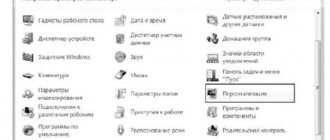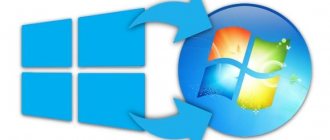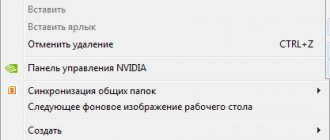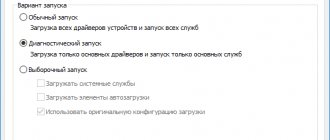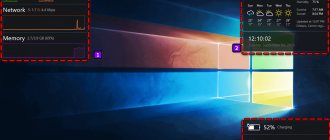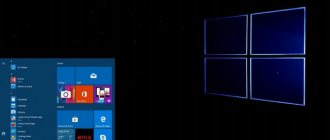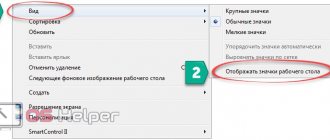When spending long periods of time at the computer, comfort is required. The more comfortable your place, the more productive your work will be. It is impossible to change the size of objects around you, but the size of your folders on your computer is easy and simple.
How to make desktop icons smaller
What to do if the icon size does not change
Restarting Explorer
The first piece of advice is trivial - first, restart your computer. In addition, it would not be amiss when setting up icons - press Ctrl+Alt+Del, open the task manager and restart Explorer.
Restarting Explorer (Task Manager)
Activation
Check whether your copy of Windows OS is activated (if it is not, a number of Windows design options do not work).
In 10, to do this, just press Win+i (to open the parameters) and go to the “Update and Security / Activation” section.
Update and Security - Activation
What theme is installed?
Some design themes may have different “presets” (including icons). Try installing the default Windows theme.
Create a new user
Try creating a new user in Windows and see if you can change the icon sizes.
To do this, press Win+R and insert the Netplwiz command into the “Run” window (confirm with Enter). Next, click on “Add” and create a new user (preferably a local account).
To help!
How to create a new user in Windows 10 (7): several methods. And also: how to make a user an administrator.
Adding an account (new PC user)
Then restart your computer and log in as a new user. Check to see if you can customize the icons.
Isn't the OS assembly "crooked"?
If a problem with customizing the Windows design arose immediately after reinstalling the OS, it is possible that you installed a non-official version of Windows (nowadays there are quite a lot of “assemblies” on the Internet from “public production”, and they can contain “anything”...).
Alternatively, I would recommend downloading the Windows 10 ISO from the official site. site (link below) and reinstall the OS (fortunately, this can be done without losing data).
To help!
How to download Windows 10 in Russian (official ISO image).
Reset the system to factory presets
Instead of reinstalling the OS, by the way, in 10 you can use a very good “Recovery” tool (returning the computer to its original state - that is, the OS settings will be reset to default).
How to open this menu (): press Win+i, go to the “Update and Security / Recovery” section.
Restore your computer to its original state
How to adjust the size of icons
You can enlarge desktop shortcuts, their font and size in different ways. One of them, available on some laptop models running Windows 8 and 10, has already been tried unsuccessfully by users. Let's move on to others.
Using the same tool
A mouse, just not a built-in one, can still serve for good. Hold down the CTRL key and turn the wheel: the icons become smaller or, conversely, larger. This is easy to do, and the method does not require digging through various settings. Suitable for those who accidentally enlarged or reduced their desktop icons.
Context menu
A method for the lazy. Just right-click and select the View tab from the context menu to change the icons. True, there are only three options to choose from: small, medium, large. While using the wheel you could adjust the icons to the ideal size for you.
By the way, there are several more convenient functions here. The View tab allows you to quickly organize your icons so they don't end up scattered all over your desktop, and there are several sorting options to choose from. In addition, labels can be removed completely (not deleted!) - then you won’t have to change their size. And at the same time you will greatly scare an inexperienced user.
Method for Windows 7
An excellent solution was applied for Windows 7, which greatly simplified the adjustment of desktop icons to the ideal look. Right-click on a free space on the desktop and select the bottommost column - “Personalization”. In the window that opens, you can change the font of the icons, make them larger or smaller, and also select a number of other custom settings to transform your desktop. Unfortunately, in Windows 10 we can change themes, wallpapers and something else through “Personalization,” but it’s very difficult to influence the icons there.
Windows 10
On Windows 10, no matter how hard you try, you won’t be able to increase or decrease the size of icons using the same settings. This can undoubtedly be considered a disadvantage of the new system. There is another special tab in the context menu that allows you to influence the shortcuts. It's called "Screen Settings". There you can move the slider to change shortcuts and everything else along with them on the desktop. In any case, the previous methods will work for Windows 10.
Reasons why desktop icons have changed their size
Some of those who have encountered the phenomenon of increased desktop icons immediately assume that some kind of malicious program has entered their computer. However, of course, this is not the case. Why would a “virus” do such things? The goal of malware now is either to steal personal data or to introduce intrusive advertising.
In fact, the reason why the icons became larger or, on the contrary, smaller, most often lies in the fact that the user himself accidentally changed them. This could happen, for example, when the desktop area was active and the user held down the CTRL key and scrolled the mouse wheel up or down.
Zoom in browser
Often when viewing various sites, the text on some is too small or too large for normal perception. The browser's built-in zoom feature helps combat this. It is also useful when using very large monitors.
In all modern browsers, you can change the scale of sites like this:
- Hold down the Ctrl key and roll the mouse wheel.
- Hold Ctrl and press the + and - keys.
- To return the site to 100% scale, use the key combination Ctrl and 0 (zero).
You can use both the regular plus, minus, zero keys and the numeric keypad keys.
Why is the information displayed on the monitor/display too small?
This problem is considered relatively new, it is directly related to the increase in resolution of display devices. If earlier, at the dawn of the mass popularization of displays, they all had a very modest resolution, now no one can be surprised by the 4K (3840 x 2160 pixels) display resolution.
And while mobile operating systems (Android, iOS) supported displaying information in a readable form on high-resolution displays from the very beginning, Windows still has problems with this to this day. This is due to the principles initially laid down when developing this OS, a large amount of already created third-party software, which a priori does not support displaying information in a comfortable form on a high-resolution display.
But, as we know, there are no hopeless situations. The situation can be improved. More on this later.
Changing the browser window scale
There are cases when the dimensions of the desktop elements and its appearance itself are perceived normally by the user, but the windows in the browser are unnecessarily enlarged. Large text leads to incorrect display of information on the monitor and to unreadable website pages in general. The situation can be corrected by reducing the size of the browser window on the computer screen as follows. Method No. 1:
1. Open a browser; 2. Find the Ctrl key on the keyboard (the lowest row of the keyboard) and “-” or “+” to increase;
3. Press them simultaneously several times until the dimensions of the letters and elements take on a size that is pleasant to read.
Changes made to the size of the browser window are performed automatically and saved after the computer is turned off. There is no need to reboot the equipment.
Method No. 2
Regardless of which browser the laptop or computer user uses, changing the scale of the page (or window) can be done using its own settings. Since Google is considered the most popular browser today, we will use its example to consider the procedure for scaling a window. Proceed as follows:
- Open browser;
- Find the icon in the form of a vertical ellipsis in the upper right corner;
- Click on the three dots;
- Select “Settings” from the menu;
- Find the “Appearance” menu in the list;
- Select the required values in the “Scaling” and “Size” items.
The parameters specified by the user will be displayed immediately on the screen.
The Google Chrome browser provides automatic saving of changes. There is no need to reboot the device. The changes made are saved even after the computer is turned off. If after specifying the required screen sizes and parameters nothing happens, restart your laptop or PC. Try again. Sometimes updates are not installed correctly, so changes are not displayed without a reboot.
How to make the Windows 10 taskbar smaller
Windows 10 has a setting that allows you to reduce the size of the taskbar , namely the size of its icons.
1. Right-click on your taskbar and select “Options” at the bottom of the menu that appears.
2. Left-click on the switch under “Use small taskbar buttons.”
Your taskbar will now shrink. To return it to its original appearance, simply click on this switch again.
Changing the screen grid through the Windows 7 Registry Editor
And finally, the most difficult method, which should be avoided by beginners and inexperienced users because it can be dangerous. In this case, the configuration is performed through the Registry Editor system application, which is a database of almost all system settings.
Important! One incorrect deletion or change of a key or its parameter can disable the operating system beyond recovery.
If you follow the instructions below, this will not happen:
- Go to the Start menu and enter “Registry Editor” in the search bar. You can also get to it through the “Run” window (key combination “Win + R”) by entering the “regedit” command.
- Go to the following path: HKEY_CURRENT_USER\ Software\ Microsoft\ Windows\ Shell\ Bags\1\Desktop.
- Find the IconSize parameter in the desktop folder, which is responsible for the size of the shortcuts.
- Open it by double-clicking the left mouse button and enter the size value in the field. 100 is the maximum and 30 is the default size.
- Apply and save all changes.
- Check icon size.
Working in the Registry Editor
There are many ways to change the appearance of icons and their sizes. You can, of course, use third-party applications, but this is of no use, since the developers have added simple and fast options for working with shortcuts to the OS functionality.
Changing and using other images
Personalization is not limited to just enlarging the small icons on the Windows 10 desktop. You can also use other icons: those that the system offers, downloaded from the Internet, or drawn yourself.
Changing the icon from the Microsoft catalog
Microsoft stores all standard interface images in Shell32.dll and imageres.dll, located in System32
Let's try to change the application icon using Google Chrome as an example:
- Right-click on the desired application and click on “Properties”;
- In the shortcut settings, open the “Properties” tab and click the button labeled “Change Icon”;
- The third-party application most likely has several versions of the icon, so you can choose any one;
- Or click the browse button and select the Shell32.dll file and select an icon from the Microsoft catalog.
In the same way, you can change the folder icon.
Changing standard icons
When using the method above, you will not be able to change the icons of the applications “My/This Computer”, “Control Panel”, “Trash” and others. To do this, you need to use other settings.
Previously, these settings were available in the Control Panel in Personalization, but now control of desktop icons in Windows 10 Pro, Home, and other editions has been moved to the Settings app.
- Open Windows Settings and select Personalization;
- Open the "Themes" tab and open "Desktop Icon Options";
- In this window, you can either add icons of standard applications to the Windows 10 desktop, or remove or edit them.
Using your own images
The image of application icons is contained in an executable file (.exe format), a library (.dll) or, most often, in an image with the corresponding format - .ico.
Integrating an icon into an executable or library is quite difficult, but creating an image is quite simple.
- First, let's create an image layout. Sizes 16×16, 32×32, 64×64 and above. Can be used like Paint, Photoshop, GIMP and any image editors.
- We find the desired image on the Internet or draw it ourselves and save it in .bmp format. Or directly to .ico, if the editor allows it.
- Then, change the format from .bmp to .ico. This is done by simply renaming.
- First, in the Explorer settings, enable the display of file formats.
- Then change the icon using the methods above.
Also, there are applications for conveniently creating icons and saving them in the correct .ico format. Such as:
- SoftOrbits Icon Maker;
- Icofx;
- Iconion;
- xiconeditor.com;
- And others.

